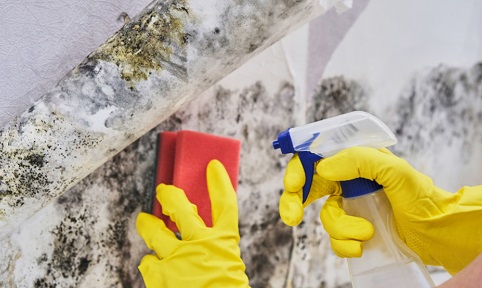10 Interesting Mold Facts You Did not Know
Best 10 Interesting Mold Facts – Mold is a fungus like mushrooms & yeast that plays an important role in helping to decompose organic matter. It grows on plants, wood, paper, fabric, cardboard, and almost anything with moisture.
The symptoms of mold can vary, but this fungus can be found in many homes and buildings. While most of them are generally benign, problems usually start when they grow and multiply, as they can expose you to several health risks and even weaken the foundation of the house.
Type of mold
Although over 100,000 mold species worldwide, many of these can be grouped into the three major types listed below.
Interesting Mold Facts
-
Allergenic
Allergic molds are considered the least dangerous per mold statistics. However, they can prove problematic for people with asthma or allergies as these fungi can trigger an attack.
-
Pathogens
This type of mold can be really very dangerous, not only for people suffering from various diseases but also for people who are generally healthy.
This is because of exposure to pathogenic molds can lead to the hypersensitivity pneumonitis (an acute reaction similar to bacterial pneumonia).
-
Toxic
This mold type can cause serious health problems because it produces mycotoxins, a harmful chemical when inhaled. The disorders caused by toxigenic molds can be either temporary (eye irritation and cough) or permanent (cancer and neurological disorders).
Interesting Mold Facts
Many homeowners hardly consider molds to be their friends. It makes sense, but many interesting things about mold will surprise, amaze, and astound you because you didn’t know. Below is a list of the interesting mold facts that will make you take a second look at this common household fungus.
-
Mold is edible
If you are a cheese-lover, there’s a good chance that you’ve eaten mold. Its active spores are part of the ingredients of blue cheese and are responsible for the rich flavor of the food.
-
Dead molds are deadly
Even after live mold spores have been killed, they can still cause problems that can last for decades. Whether alive or dead, molds can produce allergens, irritants, and potentially toxic substances that can affect your health and cause allergic reactions when inhaled or touched.
-
Mold has brains
One mold species, Physarum polycephalum, does not have a brain but uses its chemical processes to solve problems and help the organism survive. Commonly known as “the blob,” this slimy mold can be trained to work towards a goal, according to researchers.
Also, while mold can grow in unfavorable environments, they usually stick around until they find a safe place to hide and grow.
Interesting Mold Facts
-
Mold Like a Dirty Lawn
Mold can grow in unmanaged lawns, especially ones lit with dead leaves and debris. This can lead to increased pollution and allergic reactions in mold-sensitive people.
-
Fungi Are Medicines
Of the many mold facts, this one shouldn’t come as a surprise, especially if you are a serious science student. Penicillium chrysogenum, a common mold found in indoor environments, gained international attention after Alexander Fleming discovered that it produced penicillin, a natural antibiotic.
-
May mold
Although the walking mold is technically an exaggeration, some molds can take the shape of slime with actual mobility functions. These mold types can also sense their environment and change their course to avoid danger.
-
Molds are WHO-certified
Eight years ago, the World Health Organization officially declared molds to significantly contribute to many health problems, including cancer, asthma, allergies, pneumonia and miscarriage.
The WHO said mold facts show that while the fungus doesn’t directly cause death, it weakens the immune system so that more serious diseases can take root and take root.
-
Mold has sex
Microorganisms, including fungi and algae, can reproduce sexually similarly to animals and plants. Offspring can inherit genes from both of their parents and acquire new traits, although, as with fungi, sexual reproduction occurs through spores.
Often, progeny spores can bear genes from only one parent fungus. However, this is not the case with Penicillium chrysogenum, which scientists have long discovered to have so-called “sex genes.”
Interesting Mold Facts
-
Mold does not cover
This will be disappointing, but many insurance policies do not cover any damage caused by a mold infestation. Neglected mold maintenance is also not valid insurance coverage.
Mold treatment is insurable, but only if the mold develops due to an accident such as fire, lightning, or other sudden events.
-
Molds Like Christmas
One of the most surprising mold facts has to do with the yuletide season. Fresh pine trees brought indoors are often covered with mold.
It can be seen as a white canker penetrating the wood and twigs. Cytospora, a mold variety that prefers spruce trees, can cause severe indoor contamination.
Artificial trees can be used as an alternative to prevent molds from entering your home. If you still want a living Christmas tree, try removing mold spores before bringing the tree inside.
Important Achievements
Mold can be a problem when it starts growing in a home, but once you learn the many interesting things about this common household fungus, you’ll likely get a mold fact sheet.
For example, once you learn that you’ve eaten mold at some point in your life or that certain mold might be thinking the same way as your neighbor, you might be surprised.
What about the fact that you can celebrate Christmas with molds every year or that your insurance won’t pay for any home damage caused by molds?
These incredible mold facts will make you think twice about what to do with your furry guests.
If you need help with what to do despite the threat that comes with mold, consider calling in a mold removal specialist.
We hope you like our article on Top 10 Interesting Mold Facts.
Thanks for visiting US Map Time Zones

